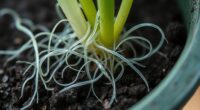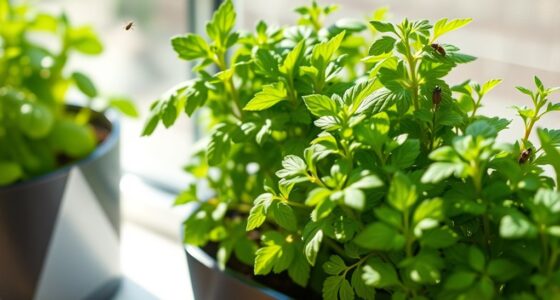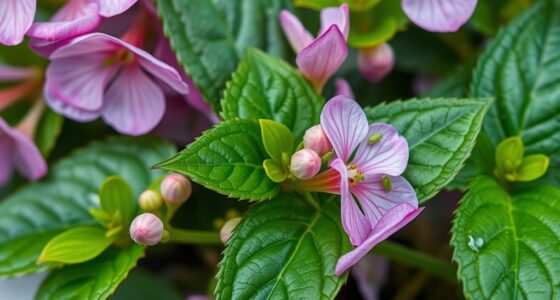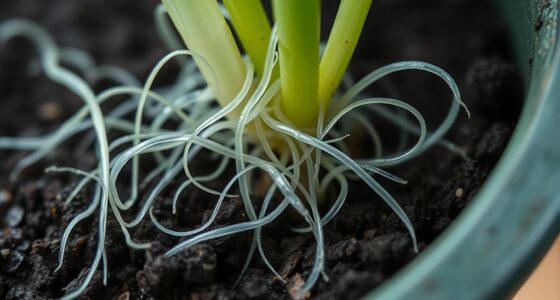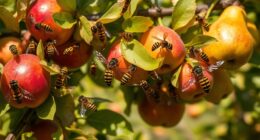To recognize thrips damage on fiddle-leaf fig leaves, look for tiny insects crawling on undersides, often with webbing or stippling. Damage appears as silvery streaks, patches, or linear scars, usually near leaf veins and on new growth. Leaves may look rough, wrinkled, or brittle, and you might spot dark specks or debris from their waste. Noticing webbing or discoloration helps confirm a thrips problem—continue exploring to learn how to effectively manage it.
Key Takeaways
- Look for tiny, fast-moving insects on the leaf undersides and tiny black specks (excrement).
- Identify irregular, streaked, or stippled damage patterns, especially near leaf veins and edges.
- Check for silvery patches, bronzing, or uneven spots that appear sunken or translucent.
- Observe webbing or stippling on leaves, indicating active thrips infestation.
- Note damage mainly on new growth, with rough, wrinkled, or brittle leaf textures.
Signs of Tiny Pests on Fiddle-Leaf Fig Leaves
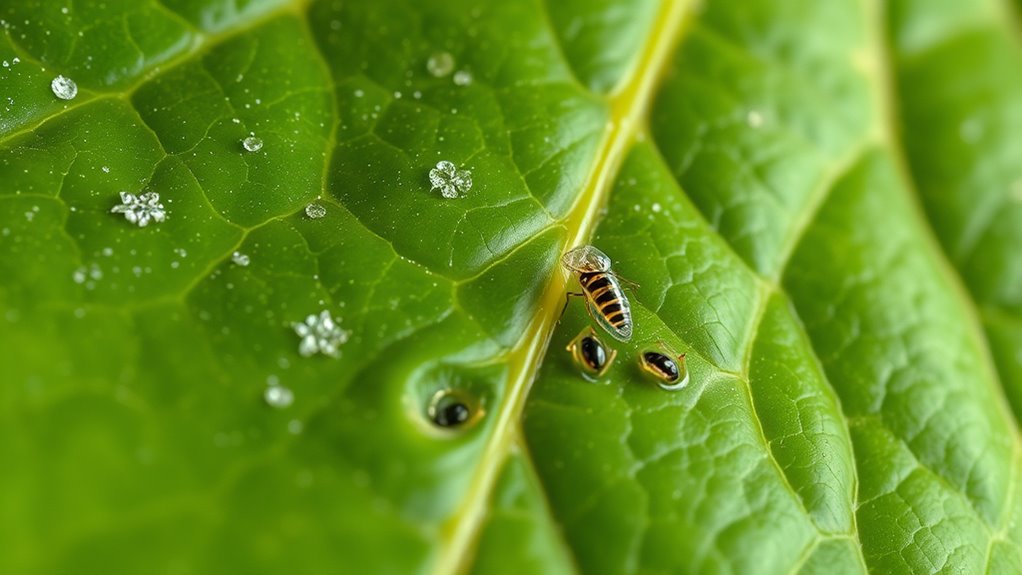
Tiny pests like thrips are often hard to spot at first, but their damage on fiddle-leaf fig leaves becomes more noticeable over time. These pests can disrupt your plant’s nutrition by feeding on leaf tissues, leading to uneven growth and weakened leaves. You might also notice that your watering habits are indirectly affected; overwatering can create a humid environment that encourages thrips, while underwatering stresses the plant, making it more vulnerable. Keep an eye out for subtle signs like silvery streaks or tiny black specks, which indicate thrips presence. Regularly inspecting your fiddle-leaf fig helps catch issues early. Maintaining proper plant nutrition and consistent watering habits can strengthen your plant’s defenses against pests like thrips. Additionally, understanding how proper care and maintenance influence pest prevention can help you develop a more effective plant care routine.
Visual Clues: Discoloration and Spotting Patterns
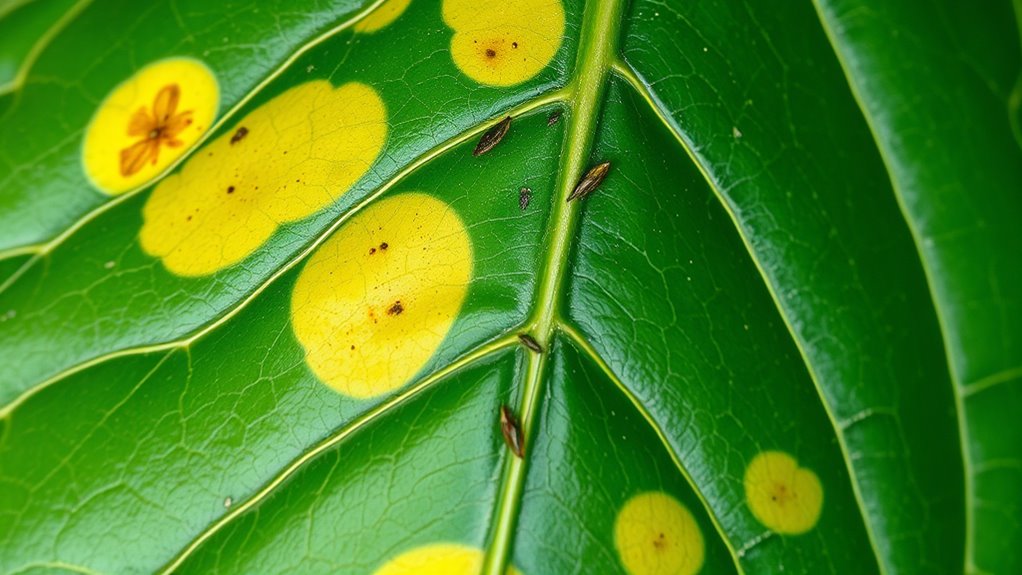
You’ll notice that thrips cause specific discoloration patterns on your plants, often appearing as streaks or patches of faded color. The spotting tends to be unevenly distributed, with clusters forming in certain areas rather than spreading uniformly. Recognizing these patterns helps you identify thrips damage early and take action promptly. Additionally, understanding plant health signals can aid in detecting underlying issues before visible damage becomes severe.
Discoloration Patterns
How can you identify thrips damage through visual cues? One clear sign is the discoloration patterns on your fiddle-leaf fig leaves. You might notice patches of yellowing or browning that start small but spread over time. Leaf spotting, often irregular and scattered, indicates thrips feeding. These spots may appear as tiny, silvery or bronze areas, reflecting the damage. Sometimes, the discoloration forms streaks along the veins or patches that contrast sharply with healthy tissue. Look closely at the affected areas to see if the leaf tissue appears translucent or sunken. Recognizing these discoloration patterns early can help you catch thrips infestations before they cause serious harm. Additionally, understanding plant health indicators can aid in early detection and effective treatment.
Spotting Distribution
Spotting distribution refers to how discoloration and damage spread across the leaves, providing clues about thrips activity. You’ll notice leaf vein discoloration where thrips often feed, creating streaks or patches along the veins. These spots may appear scattered or concentrated in specific areas, indicating active pest hiding spots. The pattern of spotting can help you determine where thrips are most active and where to focus your inspection. Typically, damage starts near the center of the leaf and moves outward, but it can also cluster near the leaf edges. By observing how discoloration and spotting are distributed, you can better understand the extent of infestation and target treatment effectively. Monitoring pest activity patterns can help you catch thrips early and protect your fiddle-leaf fig.
Examining Leaf Surfaces for Damage and Debris
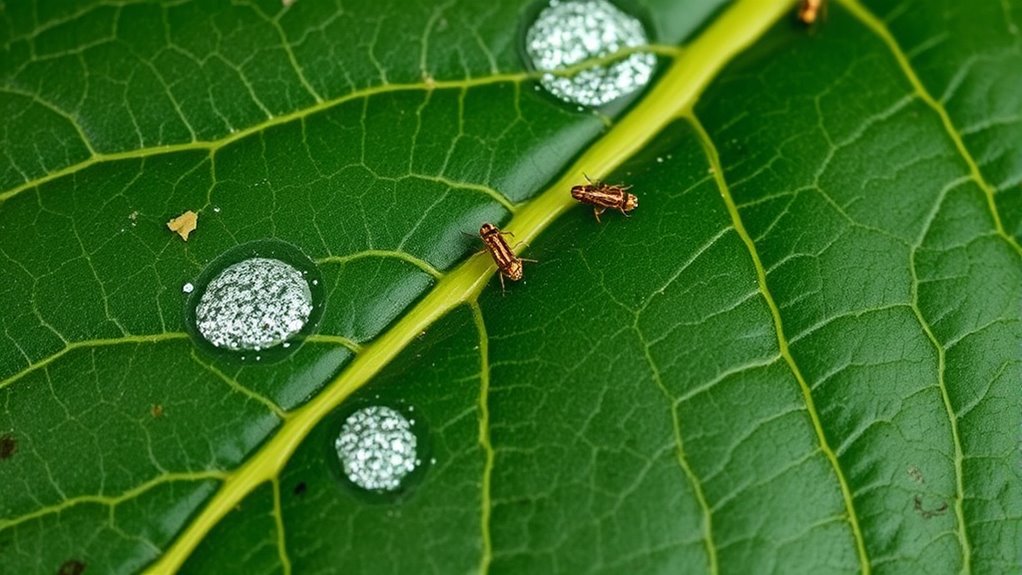
To identify thrips damage effectively, start by closely examining the surfaces of leaves. Look for tiny scratches, silver streaks, or stippling that indicate feeding. Pay attention to areas where debris accumulates, such as dust, specks, or dark particles, which can be signs of thrips activity. Gently flip over the leaf to inspect both sides, as thrips often hide underneath. Notice any rough patches or irregularities on the leaf surface; these can also signal damage. Be thorough and systematic, checking all leaves on your fiddle-leaf fig. The presence of debris accumulation combined with surface damage helps confirm an infestation, guiding you toward appropriate treatment steps. Regular inspection is key to catching thrips early and preventing further harm. Additionally, understanding the filtration systems of your cleaning tools can help you better manage pests and debris around your plants.
Detecting Webbing and Other Indications of Infestation
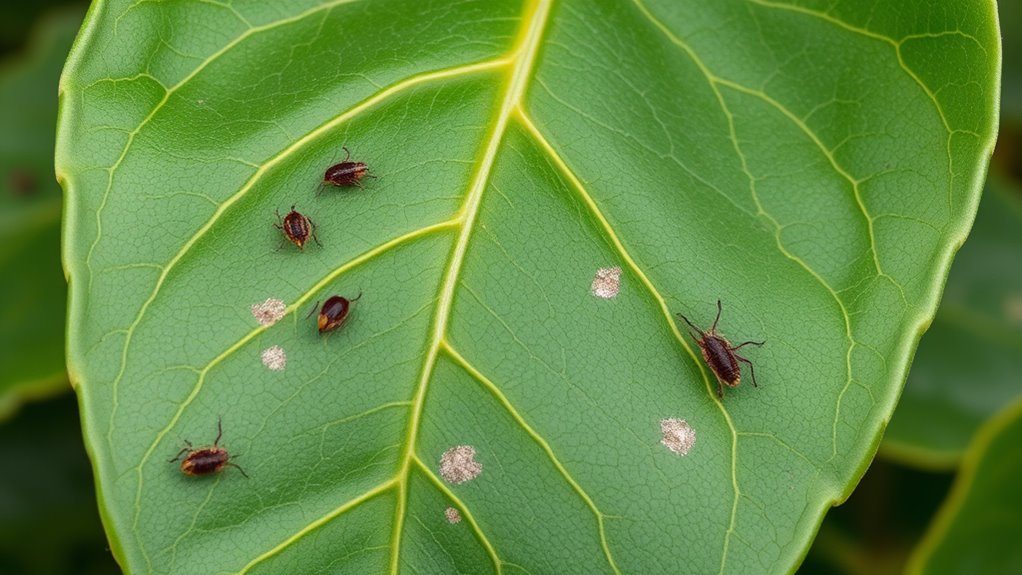
Webbing on your plant’s leaves or stems is a clear sign of thrips infestation, especially if it appears as fine, silk-like threads. This webbing formation can cover parts of the foliage, making it easier for you to spot pest activity. Along with webbing, look for other clues such as tiny moving specks or irregular leaf distortions. Pest movement patterns, like quick, darting motions, also indicate thrips presence. To help visualize, here’s a quick snapshot:
| Signs of Infestation | Webbing Formation | Pest Movement Patterns |
|---|---|---|
| Fine silk threads | Covers leaves/stems | Rapid darting |
| Disrupted leaf tissue | Feels sticky | Skittering across surface |
| Debris accumulation | Clings to foliage | Sudden movements |
Identifying these signs early helps prevent severe damage. Additionally, early detection methods are essential for managing thrips effectively.
Changes in Leaf Texture and Structural Integrity
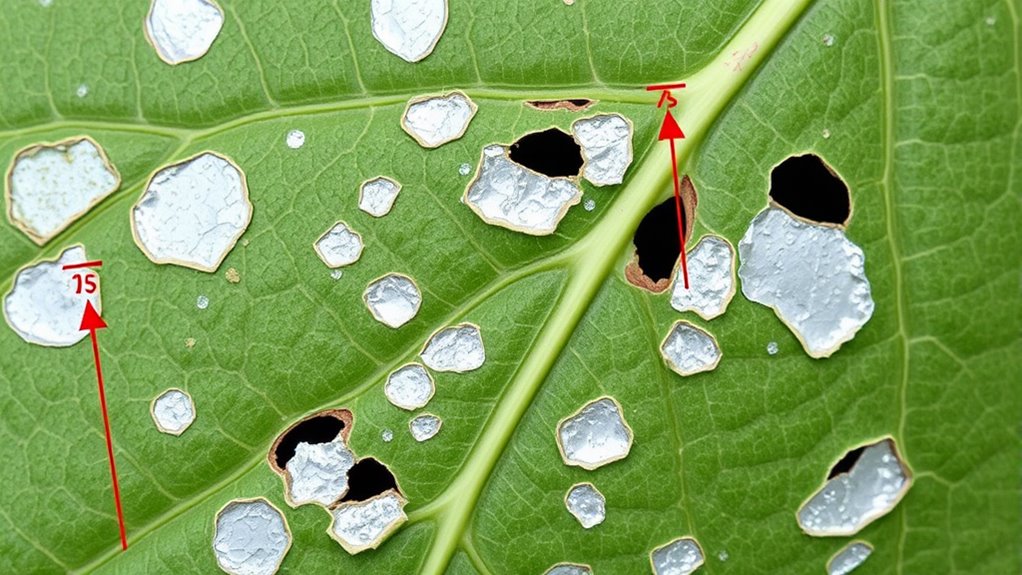
When thrips infest your plants, they often cause noticeable changes in leaf texture and structural integrity. You might observe leaves becoming rough, wrinkled, or leathery, which signals damage. The structural integrity of your fiddle-leaf fig can weaken, making leaves more fragile and prone to tearing. Look out for these specific signs:
- Thin or papery leaf texture
- Curling or puckering of leaves
- Brittle or easily broken leaf edges
- Reduced leaf stiffness and resilience
These changes occur because thrips feed on plant tissues, disrupting cell structure and moisture balance. As a result, leaves lose their firmness and smoothness. Recognizing these subtle shifts early helps you catch infestations before they worsen, maintaining the health of your plant. Additionally, understanding how plant tissue damage affects overall plant health can guide more effective pest management.
Signs of Overexposure to Pests: Drooping and Leaf Drop
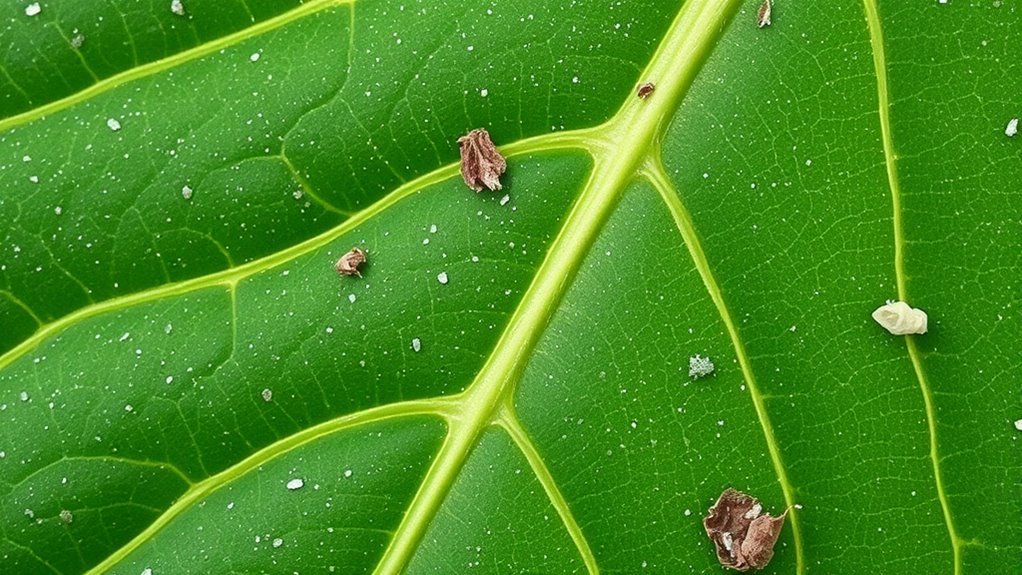
Overexposure to pests often manifests through visible signs like drooping leaves and sudden leaf drop. If your fiddle-leaf fig shows these symptoms, it’s a clear indication that pest activity may be overwhelming your plant. Thrips prevention is key to maintaining healthy foliage and preventing further damage. When pests like thrips invade, they weaken plant tissues, causing leaves to lose their turgor, which results in drooping. Leaf drop typically follows as the plant struggles to recover. To improve plant health management, inspect your plant regularly for early signs of pest presence and act promptly. Addressing pest issues early helps preserve your plant’s significance and prevents overexposure from escalating into severe damage. Consistent monitoring and targeted treatments are essential for keeping your fiddle-leaf fig thriving. Recognizing signs of pest damage can also help prevent pest infestation escalation and further deterioration of your plant’s health.
Differentiating Thrips Damage From Other Common Fiddle-Leaf Issues
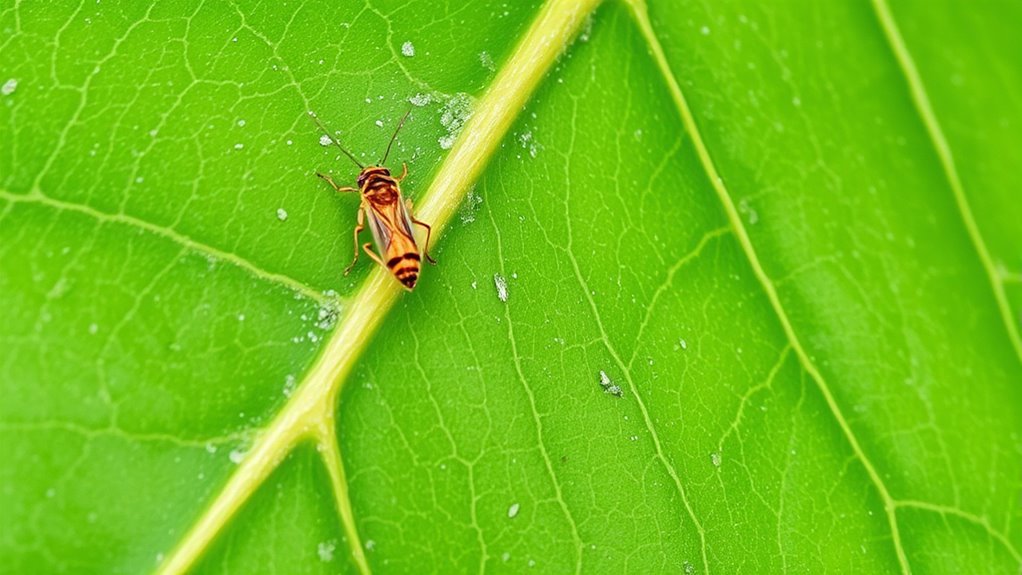
When telling thrips damage apart from other leaf issues, look closely at the visible symptoms on your plant. Pay attention to the patterns of the damage—thrips often cause tiny, silver or brown streaks and specks, unlike the larger, irregular spots from other problems. Also, check for signs of additional pests, such as tiny insects or webbing, that can help confirm thrips are the culprit. Since thrips can also be attracted to specific environmental conditions, maintaining proper indoor air quality can help prevent their infestation.
Visible Leaf Symptoms
Identifying thrips damage on fiddle-leaf figs can be challenging because its symptoms often resemble those caused by other issues. You might notice leaves with silvery or bronze patches, tiny black specks, or distorted growth. These symptoms align with thrips behavior, such as feeding on leaf surfaces and leaving behind damage that looks like streaks or speckling. To differentiate, check for small, moving insects on the undersides of leaves. Look for fine webbing or stippling. Pest control methods like insecticidal soap or neem oil can help manage thrips, but early detection is key. Keep an eye out for:
- Irregular, silvery patches
- Tiny black specks (thrips excrement)
- Distorted or deformed leaves
- Small insects crawling on leaf undersides
- Monitoring techniques can improve your chances of catching thrips early.
Damage Pattern Differences
While the visible symptoms of thrips damage can resemble those caused by other issues, examining the specific damage patterns helps distinguish them. Damage pattern differences are key: thrips tend to create tiny, silvery or bronze streaks along the leaf surface, often concentrated on new growth or leaf edges. You might notice small, irregular scars or speckling from feeding. Unlike leaf spots caused by diseases, thrips damage is more linear and less uniform. Pest behavior variations also matter; thrips are quick, discreet feeders that move between leaves, leaving behind these distinctive feeding scars. By paying close attention to these patterns and behaviors, you can accurately identify thrips damage and differentiate it from other common problems affecting your fiddle-leaf fig.
Additional Pest Indicators
Additional pest indicators are essential for accurately distinguishing thrips damage from other common issues on your fiddle-leaf fig. Thrips have a unique pest lifecycle that includes eggs, nymphs, and adults, often found on the undersides of leaves. Look for tiny, slender insects moving quickly or tiny black specks (excrement). You might also notice silvery, stippled patches on leaves caused by feeding. Unlike other pests, thrips leave behind scars that resemble small, linear streaks or spots. Chemical control options can be effective but require early detection. Keep an eye out for:
- Small, fast-moving insects on leaf undersides
- Frass or black specks near feeding sites
- Silvery or stippled leaf patches
- Visible pest lifecycle stages during inspection
Identifying these signs helps differentiate thrips from other issues like spider mites or fungal spots.
Frequently Asked Questions
How Quickly Can Thrips Infestation Damage a Fiddle-Leaf Fig?
Thrips can cause visible damage to your fiddle-leaf fig within just a few weeks. Their lifecycle is quick, often completing in around a month, which accelerates leaf damage progression. As they feed, they puncture leaves, leading to silvery streaks, spots, and distorted growth. The faster you spot and address the infestation, the better you can prevent severe damage. Regular inspection helps catch thrips early before they cause significant harm.
Are There Natural Predators to Control Thrips on Fiddle-Leaf Figs?
You might wonder if natural predator control can help manage thrips on your fiddle-leaf fig. Beneficial insects like ladybugs, predatory mites, and lacewing larvae are effective biological pest management options. These natural predators feed on thrips, reducing their numbers without chemicals. Introducing or encouraging these insects creates an eco-friendly way to control thrips naturally, helping your plant stay healthy and pest-free while supporting a balanced garden ecosystem.
Can Thrips Spread to Other Houseplants Easily?
Imagine thrips as tiny invaders, slipping from one plant to another like stealthy spies. Yes, they can spread easily if you don’t practice plant quarantine. When you suspect thrips, insect identification becomes essential to stop them in their tracks. Keep new plants isolated and inspect regularly. This way, you prevent the little pests from hitchhiking onto your other houseplants, protecting your lush indoor jungle from their silent invasion.
What Environmental Conditions Favor Thrips Infestations?
You’ll find thrips thrive in warm, dry environments with low humidity levels, which help them reproduce quickly. They also favor stressed plants, especially those experiencing drought or poor nutrition. To prevent infestations, keep your fiddle-leaf fig healthy by maintaining proper watering and humidity, and avoid sudden environmental changes. Regularly inspect your plant for signs of pests, as healthy plants are less attractive to thrips.
Are There Specific Treatments That Prevent Recurring Thrips Issues?
Imagine you’re in a sci-fi film, battling tiny invaders. To prevent thrips from returning, you should use biological control methods like introducing beneficial insects, which naturally curb thrips populations. Additionally, adopt preventative measures such as regular inspection, proper watering, and maintaining plant health. Combining these strategies helps keep thrips at bay, reducing the chances of re-infestation and ensuring your fiddle-leaf fig stays vibrant and healthy.
Conclusion
Once you spot the tiny signs of thrips, it’s like catching a sneaky thief in your garden. I once missed the early warning signs on my fiddle-leaf fig, only to see the damage spread quickly—reminding me that vigilance is your best defense. Regular checks and swift action keep pests at bay, ensuring your plant stays vibrant and healthy. Think of it as catching a whisper before it becomes a shout—your plant’s health depends on it.

